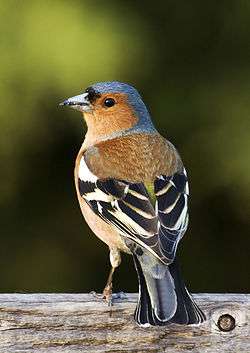Fringilla
| Fringilla | |
|---|---|
 | |
| Male common chaffinch | |
| Scientific classification | |
| Kingdom: | Animalia |
| Phylum: | Chordata |
| Class: | Aves |
| Order: | Passeriformes |
| Suborder: | Passeri |
| Infraorder: | Passerida |
| Superfamily: | Passeroidea |
| Family: | Fringillidae |
| Subfamily: | Fringillinae Leach, 1820 |
| Genus: | Fringilla Linnaeus, 1758 |
| Species | |
The genus Fringilla is a small group of finches from the Old World, which are the only species in the subfamily Fringillinae. The genus name Fringilla is Latin for "finch".[1]
The four species are:[2]
- Common chaffinch (Fringilla coelebs)
- Gran Canaria blue chaffinch (Fringilla polatzeki)
- Tenerife blue chaffinch (Fringilla teydea)
- Brambling (Fringilla montifringilla)
The common chaffinch is found primarily in forest habitats, in Europe, North Africa, and western Asia; the blue chaffinch is an island endemic; and the brambling breeds in the northern taiga and southern tundra of Eurasia.[3]
The three species are about the same size, 15 centimetres (5.9 in) in length, and are similar in shape.[3] They have a bouncing flight with alternating bouts of flapping and gliding on closed wings.[4] They are not as specialised as the other finches, eating both insects and seeds. While breeding, they feed their young on insects rather than seeds, unlike the other finches.[3]
In 2016 it was proposed that the extremely rare Gran Canaria subspecies F. teydea polatzeki be treated as a separate species, thus creating a fourth species, F. polatzeki.[5][6]
References
- ↑ Jobling, James A. (2010). The Helm Dictionary of Scientific Bird Names. London, United Kingdom: Christopher Helm. p. 164. ISBN 978-1-4081-2501-4.
- ↑ Gill, Frank; Donsker, David (eds.). "Finches, euphonias". World Bird List Version 5.2. International Ornithologists' Union. Retrieved 5 June 2015.
- 1 2 3 Newton, Ian (1973). Finches. New Naturalist 55. New York: Taplinger. pp. 19–30. ISBN 0-8008-2720-1.
- ↑ Clement, Peter; Harris, Alan; Davis, John (1993). Finches and Sparrows. Princeton, New Jersey: Princeton University Press. ISBN 0-691-03424-9.
- ↑ Sangster, G.; Rodríguez‐Godoy, F.; Roselaar, C.S.; Robb, M.S.; Luksenburg, J.A. (2016). "Integrative taxonomy reveals Europe's rarest songbird species, the Gran Canaria blue chaffinch Fringilla polatzeki". Journal of Avian Biology. 47 (2): 159–166. doi:10.1111/jav.00825.
- ↑ "The Rarest Songbird in Europe". Wildlife Articles. Retrieved 2016-03-05.